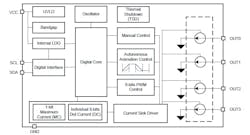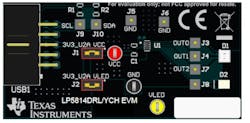Tiny RGBW LED Driver Promotes Smart Lighting Control
What you'll learn:
- Why a self-contained “LED effects” manager may be a good system-wide design option.
- The many actions that this LED driver can initiate while offloading the processor.
- How a new evaluation module helps designers use this IC effectively.
When it comes to integrated circuits, what you see is usually what you get. The most advanced ICs can feature tens or even hundreds of contact leads or bumps, reflecting the internal complexity of the device that can comprise a wide range of building blocks and operating modes. On the other hand, some ICs feature only a few leads and a single internal function, such as operational amplifiers. While it can be configured to play many different roles in a system, the device itself is still just an op amp.
But Texas Instruments recently introduced a multichannel LED driver that's more than meets the eye. The four-channel RGBW LED driver controls red, green, blue, and white color LEDs and features autonomous animation engine control. The LP5814I offers both analog- and PWM-dimming modes to implement powerful dimming capabilities and performance, and it comes in a very compact 8-lead, 1.36- × 0.8-mm package with 0.35-mm pitch (Fig. 1).
Applications include personal electronics products such as virtual-reality (VR) headsets, gaming controllers and peripherals, electronic and robotic toys, video doorbells and conference systems, and even smart and wireless speakers. The hardware configuration is simple in a representative design (Fig. 2).
One question that came to mind: Why would you need this type of device in the first place? After all, many of the LED dimming and blinking modes it supports could be implemented directly by the system processor.
One possible reason is that the processor in a low-cost consumer product simply can’t spare the performance needed to manage all of these LED control functions. In fact, the need for such LED-control functions could force the designer to select a larger, more expensive MCU.
In contrast, a device like TI’s new LED driver makes it possible to use a more compact and power-efficient CPU. The autonomous animation engine function of this LED driver significantly reduces the real-time loading of the controller.
Each LED can be configured through the related registers to deliver vivid and fancy lighting effects. The LP5814I also provides an “instant blinking” capability for applications that require LED indications even before the system controller is ready to send commands after powering up.
The output current of each LED is able to be adjusted with 256 steps from 0.1 mA to 25.5 mA or 0.2 mA to 51 mA. TI said the 8-bit pulse-width modulation (PWM) inside the IC enables smooth and audible-noise-free (23 kHz) dimming control for LED brightness.
Connection to the local processor is via a 1-MHz I2C interface. Supply voltage (Vcc) range is 2.5 V to 5.5 V; logic pins are compatible with 1.8-, 3.3-, and 5-V levels while output voltage can range up to 5.5 V. The device has ultra-low operation current of 0.1 µA in shutdown mode, 0.1 mA when enabled, and 0.2 mA when illuminating LEDs (all typical). For more details on the LED driver, check out the 80-page datasheet.
It will probably take some time to experiment with the IC to get the desired LED color, shape, blinking, and dimming patterns (plus, it might be fun). To facilitate this, TI offers the LP5814DRLEVM evaluation module and companion LP581x_RUKA PC-based GUI software to help designers exercise the IC (and others in the family) (Fig. 3).
This new device proves that powerful attributes can come in very small packages — that’s for sure.
About the Author

Bill Schweber
Contributing Editor
Bill Schweber is an electronics engineer who has written three textbooks on electronic communications systems, as well as hundreds of technical articles, opinion columns, and product features. In past roles, he worked as a technical website manager for multiple topic-specific sites for EE Times, as well as both the Executive Editor and Analog Editor at EDN.
At Analog Devices Inc., Bill was in marketing communications (public relations). As a result, he has been on both sides of the technical PR function, presenting company products, stories, and messages to the media and also as the recipient of these.
Prior to the MarCom role at Analog, Bill was associate editor of their respected technical journal and worked in their product marketing and applications engineering groups. Before those roles, he was at Instron Corp., doing hands-on analog- and power-circuit design and systems integration for materials-testing machine controls.
Bill has an MSEE (Univ. of Mass) and BSEE (Columbia Univ.), is a Registered Professional Engineer, and holds an Advanced Class amateur radio license. He has also planned, written, and presented online courses on a variety of engineering topics, including MOSFET basics, ADC selection, and driving LEDs.



